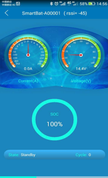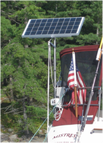 Bluetooth battery monitor app Bluetooth battery monitor app This year we replaced our lead acid batteries with LiFePo4 (Lithium Iron Phosphate) batteries. We wanted to learn how this technology functioned in a marine cruising environment and analyze how this technology operated with our solar system. Battery Configuration - After considerable research, we selected a 100 Amp Hour (Ah) battery manufactured to our specification with a 150 amp draw Battery Management System (BMS) and Bluetooth capability. We worked closely with our manufacturer to design the best battery for the marine environment. We replaced our house bank of three 110 Ah lead acid batteries with two 100 Ah LiFePo4 batteries and replaced our 110 Ah lead acid start battery with a single 100 Ah LiFePo4 battery. We have three charging systems onboard; a 75 amp Balmar alternator with smart regulator, a Xantrex 55 amp inverter/charger for shore power and a 175 watt solar system with an EP Xtra-N Li capable solar controller. We have a Link 2000 battery monitoring system. We were able to replace our three battery house bank with two LiFePo4 batteries because the LiFePo4 batteries can be safely discharged 90% (180 Ah) whereas the lead acid can be safely discharged only 50% (165 Ah). Findings Summary - These batteries performed beyond our expectations. They took everything we could throw at them through heavy charging and discharging. They proved to be plug compatible with our existing charging systems and compatible with our onboard appliances. The only disadvantage we could come up with is the cost but this is mitigated by the life expectancy of these batteries. We will keep these batteries onboard for a long time. Below are some specifics on our observations. Bluetooth - The Bluetooth capability enables real time monitoring of each battery through an app on a smartphone. The system displays the state of charge of the battery, the amp draw and voltage level, the temperature, the time to full charge and the number of charge/discharge cycles. We found this feature to be valuable in monitoring the performance and characteristics of each battery in the battery bank. It was almost equivalent to having a built in battery bank monitoring system like our Link 2000. Charge/discharge cycles - The LifePo4 batteries have an expected life of 3,000-4,000 charge/discharge cycles at a discharge to 90%. Lead acid batteries have an expected life of 300-400 charge/discharge cycles at a discharge to 50%. During our 6 week cruise we never plugged into shore power and the BMS recorded only 11 cycles. I'm not sure what constitutes a cycle but will research this in the coming weeks. See my earlier blog post for a description of our power usage profile. Discharge profile - The two battery LiFePo4 house bank discharge profile is significantly different from a lead acid bank. The LiFePo4 bank stayed between 13 and 13.4 volts up to our maximum discharge which was about 75%. We anticipate the bank voltage would have dropped off rapidly at about 90% discharge. A lead acid battery decreases in voltage as more current is drawn. The contrast in voltage drop seemed significant in the performance of our refrigeration (our major appliance). It ran at peak efficiency all the time. While difficult to quantify, it appeared our power consumption in a 24 hour period was less with the LiFePo4 batteries than last year with the lead acid battery bank. Discharge rate - The BMS built into these batteries has a 150 amp discharge capacity. This means the batteries can sustain a heavy discharge without damage or degradation. Our manufacturer has advised us that the quality of the cells and quality of the BMS is key to the longevity and performance of a LiFePo4 battery. We have seen this firsthand. Weight - Each 100 Ah battery weighs about 31 pounds. A comparable lead acid battery is about twice that. We replaced a four battery lead acid battery system weighing over 200 pounds with a three battery system weighing 93 pounds. Safety - Li batteries have a reputation for catching fire. Not so with LiFePo4, a very different technology. The built in Battery Management System monitors the state of charge of each cell group and controls the charge and discharge rates. These batteries have two major components, the LiFePo (Lithium Iron Phosphate) cells and the BMS (computer) the components are housed in a sealed battery case. There are no toxic chemicals or gases as in lead acid batteries. The batteries can be mounted in any direction; bottom or side. Compatibility - Our key concern in installing LiFePo4 batteries was compatibility with our existing charging systems and appliances. We discussed this at great length with our manufacturer. They reviewed the specs of each of our systems and gave us the thumbs up on compatibility. It appears they were correct as to date we have had no compatibility issues. Cost - LiFePo4 batteries are 3 to 5 times the cost of lead acid type batteries. Cost justification has to be based on convenience, performance and longevity. It haven't run the numbers yet but based on the number of cycles these batteries can support, there is a break even somewhere around 8 years not taking into consideration all the intangible benefits. Winter Storage - The LiFePo4 batteries can be stored in temperatures of 20 below zero. It is recommended that the negative terminals be disconnected so there is no chance of draining the batteries while in storage. The good news is that these batteries don't have to be removed from the boat in the winter. Bottom line - LiFePo4 marine batteries with the configuration we tested are lighter, can be drawn down 90%, hold a steady voltage, are plug compatible, and charge more quickly than lead acid batteries. They are nontoxic and safe. They are more expensive than lead acid. Contact me anytime to discuss how this technology might be applied to your marine application. Tom
3 Comments
 This year we tested our new 175 Watt SunPower cell solar panel with our integrated water heating system on a 6 week cruise in Northern Lake Huron at a latitude of about 46 degrees. We used an EP Xtra-N 20 amp MPPT Controller. The 175 watt panel provided plenty of power to meet our 70 amp hour per day requirements. The 175 watt panel was mounted using our CMP pole mounting system so I could tilt and rotate the panel to achieve optimum sun angle. I set the sun angle once and rotated the panel three times a day (morning, midday, evening) and estimate we got about 30% more performance over a fixed horizontally mounted panel. Operating statistics: Our power usage averaged approximately 70 amp hours or 850 watt hours in a 24 hour period. Our current draw was from a refrigerator/freezer running 24/7, our LED lights in the evening, cell phone chargers, laptop computer several hours a day and our radios and instruments during the day. Our windlass is only run when the engine is running so we don't include it in our power consumption calculation as the alternator quickly makes up for its power usage. We have a 75 amp Balmar alternator with a smart regulator. We changed our battery system this year by installing two 100 amp hour CMP LiFePo4 batteries for our house bank and one for our starting battery. I will post more about these batteries and our exciting findings soon. We started the engine to move anchorages about every three days. Results and findings: 1. Our battery bank was fully charged by 1 PM most sunny or mostly sunny days when at anchor. This is about the same charging time that we experienced last year with the 160 watt solar panel. 2. The EP Xtra-N MPPT controller with the remote display proved to be an outstanding piece of equipment. It was simple to program, easy to read, collected the appropriate data and was very efficient. It was exciting (I get excited about these things) to see 6 to 10 amps being poured into the battery bank in the morning. It would be frustrating to see it only outputting and amp or two in the afternoon in full sun but then you realize it is doing its job. It fully charged the batteries in the morning and was in float mode topping off the battery bank in the afternoon. 3. Because we have excess power in the afternoon on sunny days, we installed an inverter and purchased an ice maker. This turned out to be worthwhile purchase. Ice for drinks was a free luxury (power wise) that we really enjoyed. 4. Rotating the panel during the day, especially in the morning, significantly increased the power generation of the panel. 5. The data gathered confirmed that this panel configuration supplied all the power we needed and had excess capacity to catch up on battery charge after a string of cloudy days. 6. The panel was affected by shading as would be expected. Occasionally the panel was shaded by the back stay or the mast. While the shading was minimal, it degraded the performance by up to 40%. 7. We installed a new larger heat exchanger on the back of the panel for our water heating system This worked well on those sunny days so we had warm water for showers and dish washing. Power consumption of this system was minimal. Data: 175 Watt Solar Panel At anchor Motor Sunny to Cloudy to Mostly Sunny Mostly Cloudy Average watt hrs per day 750 480 900 435 Average amp hours per day 58 37 69 33 Maximum watt output in 24 hours 1,280 750 1,280 570 Maximum amp hours in 24 hours 98 58 98 44 160 Watt Solar Panel At anchor Motor Sunny to Cloudy to Mostly Sunny Mostly Cloudy Average watt hrs per day 660 480 700 400 Average amp hours per day 51 37 54 31 Maximum watt output in 24 hours 1,210 770 1,210 770 Maximum amp hours in 24 hours 93 59 93 59 Observations: 1. The minimum watt hour output doesn't mean much because it is dependent on both the cloud cover and the state of charge of the bank as a result of alternator charging, 2. The maximum watt hours per day of 1,280 is not the maximum output capacity of the system in a 24 hour period because the batteries were charged by 1 PM so the controller shut down the charge from the panel. A higher drain on the house battery bank would have resulted in this number being higher. 3. Average amp hours per day is computed by dividing the watt hours by 13 volts. This is a ballpark calculation. 4. This configuration proved to have plenty of capacity for our cruising needs even without using an auxiliary flexible solar panel we store under a bunk. We did not use shore power to charge our battery bank for the entire summer. Solar Water Heater: We installed our new solar water heating system. It consists of a heat collector or heat exchanger mounted on the back of the solar panel, and a circulating pump. See our earlier blog for design considerations. The pump circulates water from the water heater through the heat exchanger on the panel. We used the same configuration on our 120 watt panel last year. Results: On sunny days at anchor we had warm water for showers and dish washing. The water temperature in our 6 gallon hot water tank would warm from 60 degrees to about 105 degrees in 2-3 hours on a sunny calm day. As expected, we confirmed that strong winds tend to cool the panel and reduce the heating efficiency as do clouds. Overall, the water heating system cools the surface of the panel by at least 20 degrees. This increases the efficiency of the panel since solar panel performance degrades as they are heated by the sun. Insulating the tubing running between the heat exchanger and the water heater significantly increased the efficiency of the system. In conclusion, the radiant energy water heating system works well on sunny days with both our larger and our standard sized panels. See our product section or read our earlier blog for details. |
Categories
All
AuthorThomas Trimmer has been cruising with his Ericson 38 sailboat on the Great Lakes for over 20 years. He has pioneered the use of solar energy for wilderness cruising. He is continually designing and building equipment to simplify and enhance the cruising experience. Archives
April 2024
|
Efficiently Powering Your Vessel/Van. Call/email/chat any time, we're happy to help you work through designing your solar system.
Home Page Solar Panels Mounting Kits Product Page Marine Solar Systems Gallery of Installations Customer Comments Contact Us
Call 248 705-8337 or email [email protected]
Article On How To Size Your Solar Panels For Your Boat
Customer Reviews Return Policy Privacy Policy Shipping Times/Rates
Home Page Solar Panels Mounting Kits Product Page Marine Solar Systems Gallery of Installations Customer Comments Contact Us
Call 248 705-8337 or email [email protected]
Article On How To Size Your Solar Panels For Your Boat
Customer Reviews Return Policy Privacy Policy Shipping Times/Rates

 RSS Feed
RSS Feed